Analysis of Accounting Fraud Cases: Enron, WorldCom, Adelphia, Tyco
VerifiedAdded on 2022/11/17
|7
|1816
|105
Report
AI Summary
This report delves into major accounting fraud cases, including Enron, WorldCom, Adelphia, and Tyco, analyzing the circumstances that led to these scandals and their subsequent impact on accounting practices and standards. The report explores the roles of internal and external auditors, highlighting failures in integrity, honesty, and independence. It examines key journal articles that discuss these cases, detailing the causes, effects, and the resulting changes in accounting regulations, such as SAS 99 and CAS 240. The analysis covers issues like non-disclosure of financial information, conflicts of interest, audit failures, and exploitation of accounting techniques. The report emphasizes the importance of learning from these historical events to prevent similar mistakes and ensure ethical financial reporting. The report concludes by stressing the importance of auditors performing their duties effectively so that companies are free from any kind of corruption related to their financial matters.
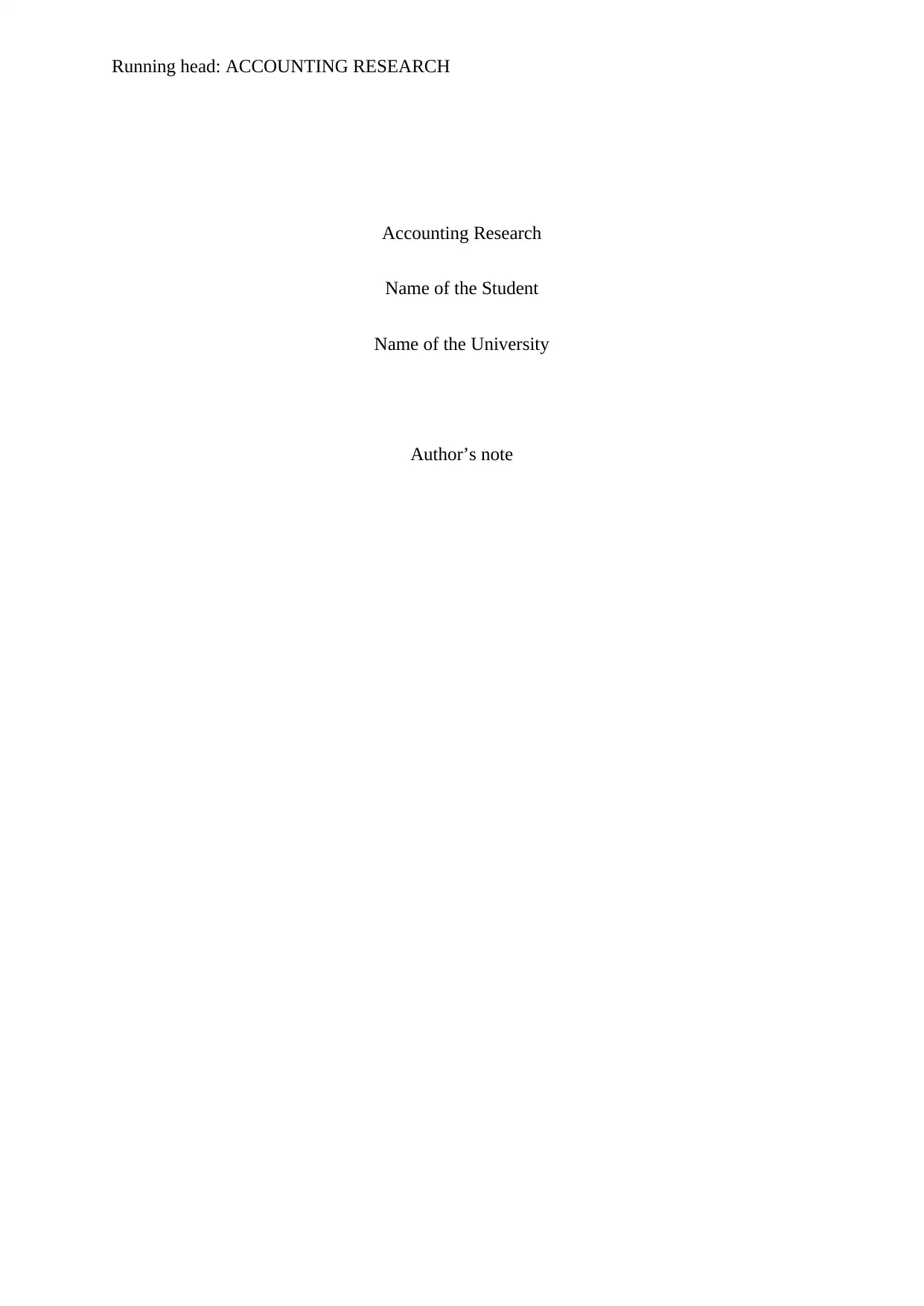
Running head: ACCOUNTING RESEARCH
Accounting Research
Name of the Student
Name of the University
Author’s note
Accounting Research
Name of the Student
Name of the University
Author’s note
Paraphrase This Document
Need a fresh take? Get an instant paraphrase of this document with our AI Paraphraser
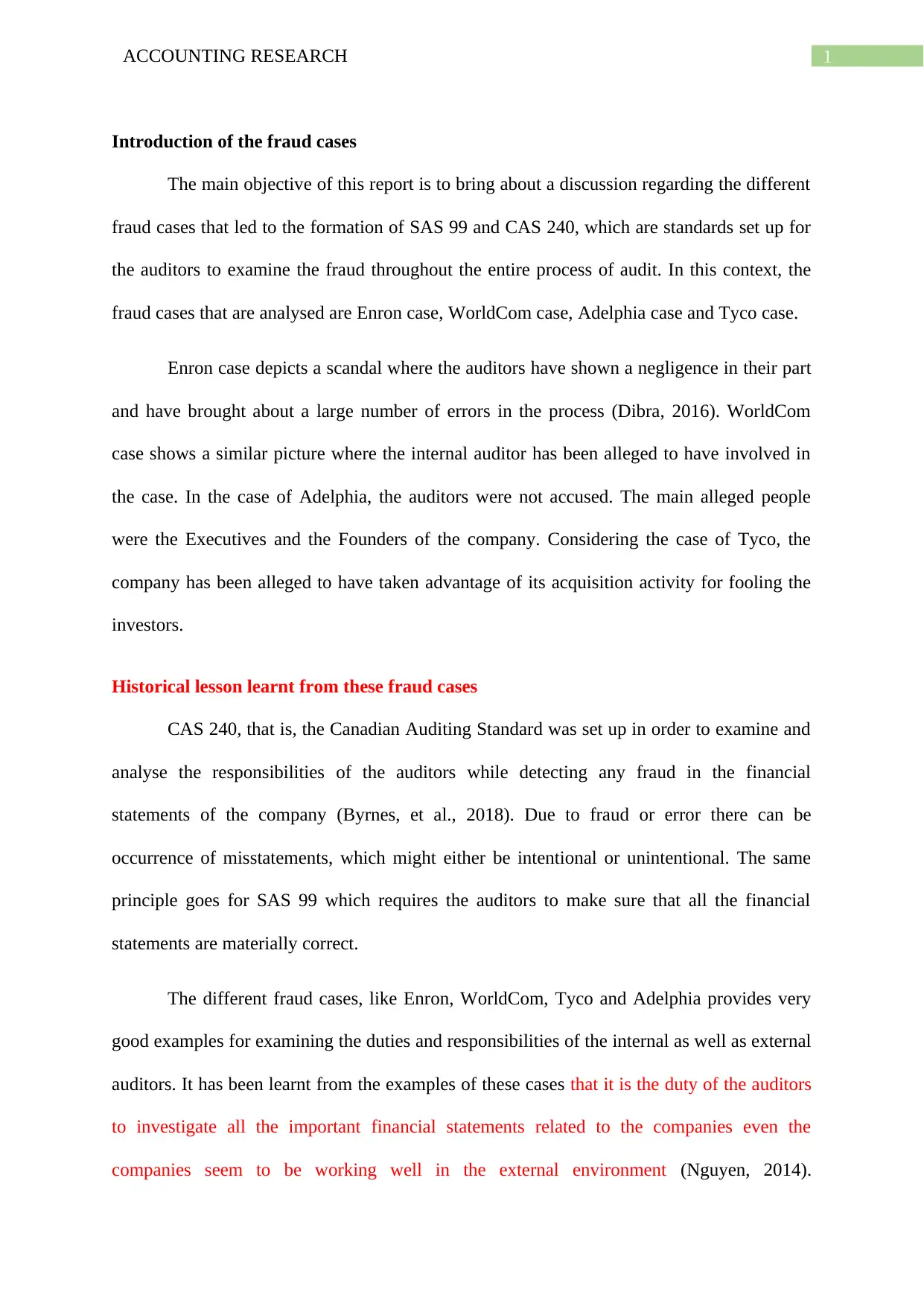
1ACCOUNTING RESEARCH
Introduction of the fraud cases
The main objective of this report is to bring about a discussion regarding the different
fraud cases that led to the formation of SAS 99 and CAS 240, which are standards set up for
the auditors to examine the fraud throughout the entire process of audit. In this context, the
fraud cases that are analysed are Enron case, WorldCom case, Adelphia case and Tyco case.
Enron case depicts a scandal where the auditors have shown a negligence in their part
and have brought about a large number of errors in the process (Dibra, 2016). WorldCom
case shows a similar picture where the internal auditor has been alleged to have involved in
the case. In the case of Adelphia, the auditors were not accused. The main alleged people
were the Executives and the Founders of the company. Considering the case of Tyco, the
company has been alleged to have taken advantage of its acquisition activity for fooling the
investors.
Historical lesson learnt from these fraud cases
CAS 240, that is, the Canadian Auditing Standard was set up in order to examine and
analyse the responsibilities of the auditors while detecting any fraud in the financial
statements of the company (Byrnes, et al., 2018). Due to fraud or error there can be
occurrence of misstatements, which might either be intentional or unintentional. The same
principle goes for SAS 99 which requires the auditors to make sure that all the financial
statements are materially correct.
The different fraud cases, like Enron, WorldCom, Tyco and Adelphia provides very
good examples for examining the duties and responsibilities of the internal as well as external
auditors. It has been learnt from the examples of these cases that it is the duty of the auditors
to investigate all the important financial statements related to the companies even the
companies seem to be working well in the external environment (Nguyen, 2014).
Introduction of the fraud cases
The main objective of this report is to bring about a discussion regarding the different
fraud cases that led to the formation of SAS 99 and CAS 240, which are standards set up for
the auditors to examine the fraud throughout the entire process of audit. In this context, the
fraud cases that are analysed are Enron case, WorldCom case, Adelphia case and Tyco case.
Enron case depicts a scandal where the auditors have shown a negligence in their part
and have brought about a large number of errors in the process (Dibra, 2016). WorldCom
case shows a similar picture where the internal auditor has been alleged to have involved in
the case. In the case of Adelphia, the auditors were not accused. The main alleged people
were the Executives and the Founders of the company. Considering the case of Tyco, the
company has been alleged to have taken advantage of its acquisition activity for fooling the
investors.
Historical lesson learnt from these fraud cases
CAS 240, that is, the Canadian Auditing Standard was set up in order to examine and
analyse the responsibilities of the auditors while detecting any fraud in the financial
statements of the company (Byrnes, et al., 2018). Due to fraud or error there can be
occurrence of misstatements, which might either be intentional or unintentional. The same
principle goes for SAS 99 which requires the auditors to make sure that all the financial
statements are materially correct.
The different fraud cases, like Enron, WorldCom, Tyco and Adelphia provides very
good examples for examining the duties and responsibilities of the internal as well as external
auditors. It has been learnt from the examples of these cases that it is the duty of the auditors
to investigate all the important financial statements related to the companies even the
companies seem to be working well in the external environment (Nguyen, 2014).
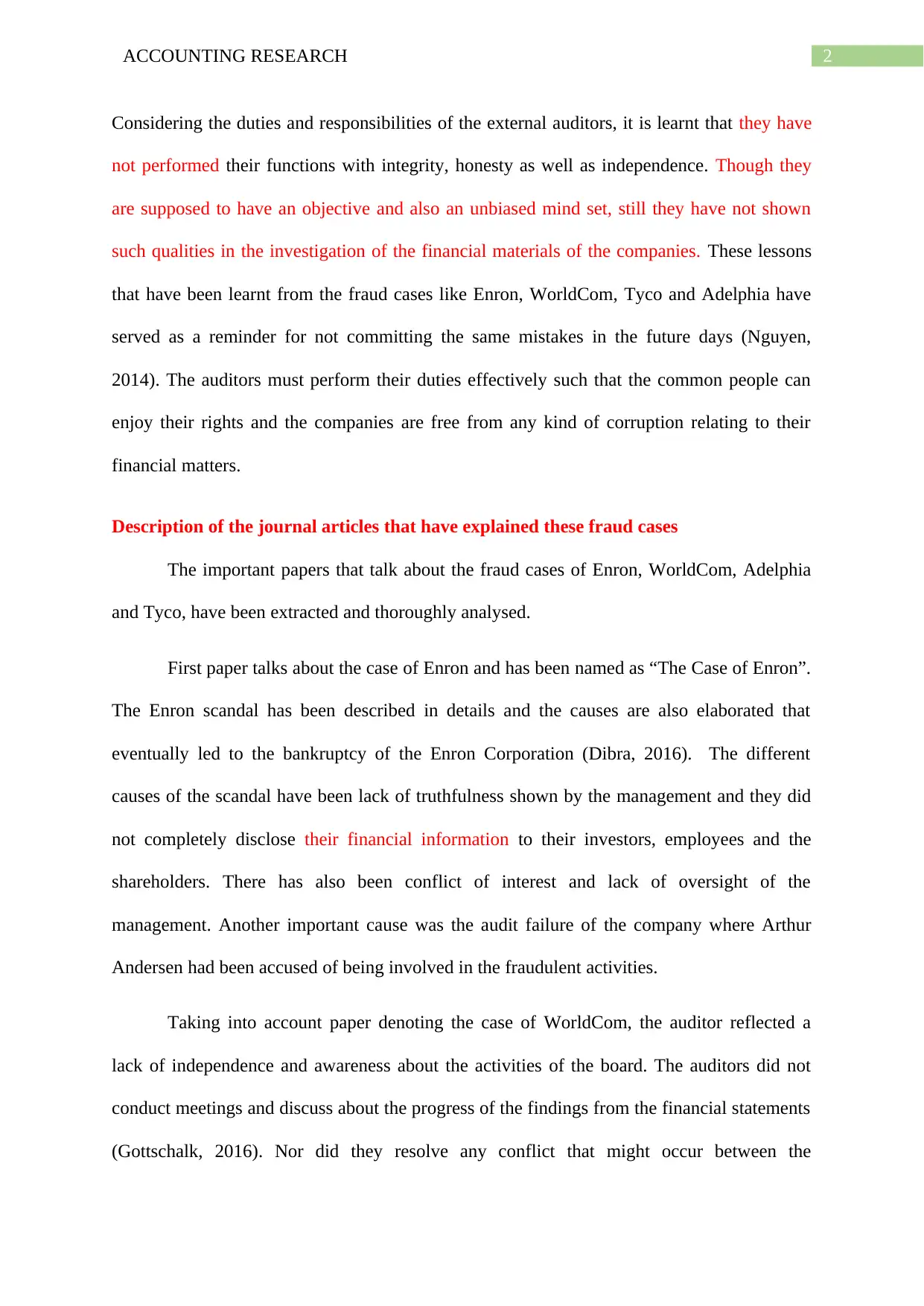
2ACCOUNTING RESEARCH
Considering the duties and responsibilities of the external auditors, it is learnt that they have
not performed their functions with integrity, honesty as well as independence. Though they
are supposed to have an objective and also an unbiased mind set, still they have not shown
such qualities in the investigation of the financial materials of the companies. These lessons
that have been learnt from the fraud cases like Enron, WorldCom, Tyco and Adelphia have
served as a reminder for not committing the same mistakes in the future days (Nguyen,
2014). The auditors must perform their duties effectively such that the common people can
enjoy their rights and the companies are free from any kind of corruption relating to their
financial matters.
Description of the journal articles that have explained these fraud cases
The important papers that talk about the fraud cases of Enron, WorldCom, Adelphia
and Tyco, have been extracted and thoroughly analysed.
First paper talks about the case of Enron and has been named as “The Case of Enron”.
The Enron scandal has been described in details and the causes are also elaborated that
eventually led to the bankruptcy of the Enron Corporation (Dibra, 2016). The different
causes of the scandal have been lack of truthfulness shown by the management and they did
not completely disclose their financial information to their investors, employees and the
shareholders. There has also been conflict of interest and lack of oversight of the
management. Another important cause was the audit failure of the company where Arthur
Andersen had been accused of being involved in the fraudulent activities.
Taking into account paper denoting the case of WorldCom, the auditor reflected a
lack of independence and awareness about the activities of the board. The auditors did not
conduct meetings and discuss about the progress of the findings from the financial statements
(Gottschalk, 2016). Nor did they resolve any conflict that might occur between the
Considering the duties and responsibilities of the external auditors, it is learnt that they have
not performed their functions with integrity, honesty as well as independence. Though they
are supposed to have an objective and also an unbiased mind set, still they have not shown
such qualities in the investigation of the financial materials of the companies. These lessons
that have been learnt from the fraud cases like Enron, WorldCom, Tyco and Adelphia have
served as a reminder for not committing the same mistakes in the future days (Nguyen,
2014). The auditors must perform their duties effectively such that the common people can
enjoy their rights and the companies are free from any kind of corruption relating to their
financial matters.
Description of the journal articles that have explained these fraud cases
The important papers that talk about the fraud cases of Enron, WorldCom, Adelphia
and Tyco, have been extracted and thoroughly analysed.
First paper talks about the case of Enron and has been named as “The Case of Enron”.
The Enron scandal has been described in details and the causes are also elaborated that
eventually led to the bankruptcy of the Enron Corporation (Dibra, 2016). The different
causes of the scandal have been lack of truthfulness shown by the management and they did
not completely disclose their financial information to their investors, employees and the
shareholders. There has also been conflict of interest and lack of oversight of the
management. Another important cause was the audit failure of the company where Arthur
Andersen had been accused of being involved in the fraudulent activities.
Taking into account paper denoting the case of WorldCom, the auditor reflected a
lack of independence and awareness about the activities of the board. The auditors did not
conduct meetings and discuss about the progress of the findings from the financial statements
(Gottschalk, 2016). Nor did they resolve any conflict that might occur between the
⊘ This is a preview!⊘
Do you want full access?
Subscribe today to unlock all pages.

Trusted by 1+ million students worldwide
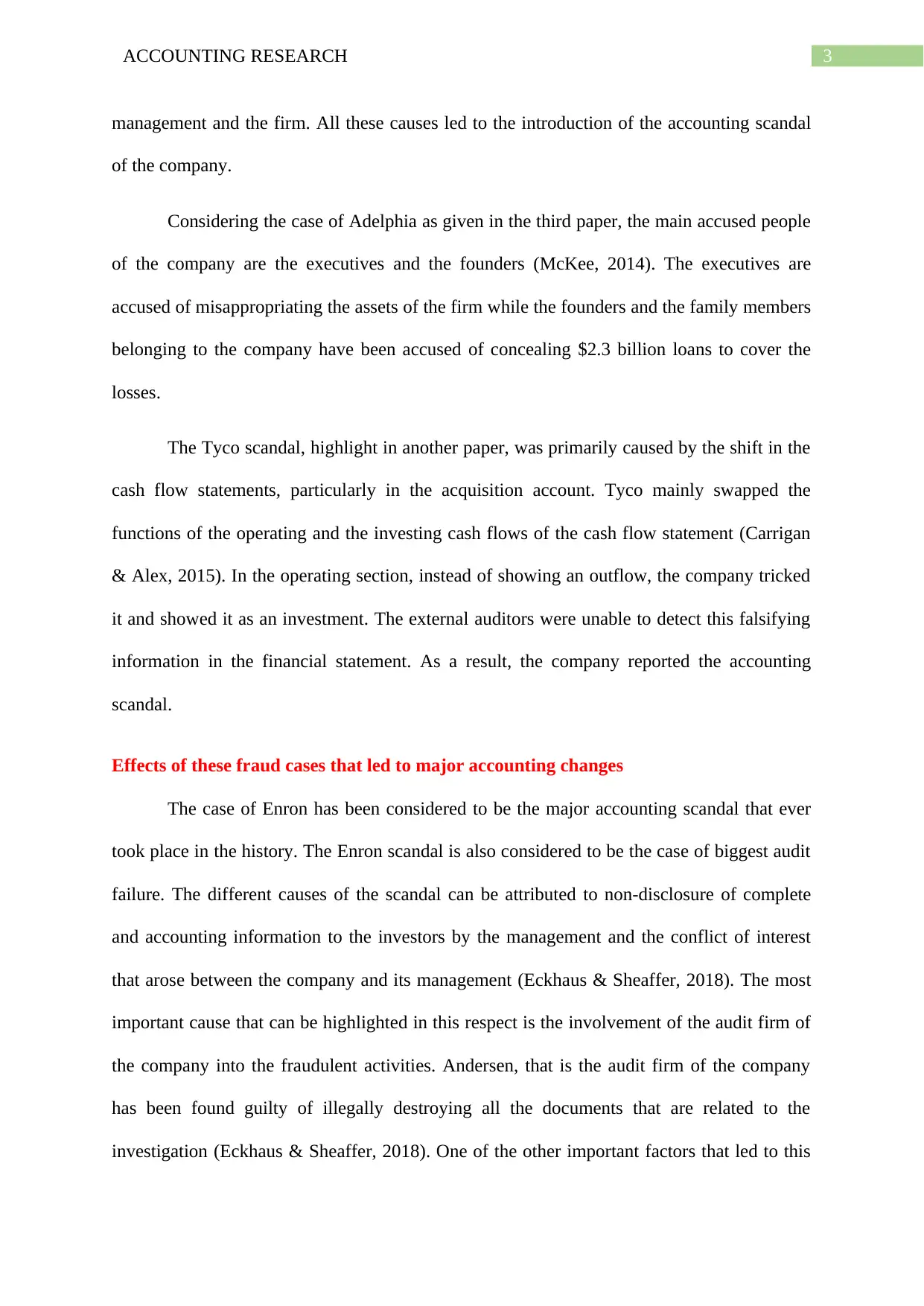
3ACCOUNTING RESEARCH
management and the firm. All these causes led to the introduction of the accounting scandal
of the company.
Considering the case of Adelphia as given in the third paper, the main accused people
of the company are the executives and the founders (McKee, 2014). The executives are
accused of misappropriating the assets of the firm while the founders and the family members
belonging to the company have been accused of concealing $2.3 billion loans to cover the
losses.
The Tyco scandal, highlight in another paper, was primarily caused by the shift in the
cash flow statements, particularly in the acquisition account. Tyco mainly swapped the
functions of the operating and the investing cash flows of the cash flow statement (Carrigan
& Alex, 2015). In the operating section, instead of showing an outflow, the company tricked
it and showed it as an investment. The external auditors were unable to detect this falsifying
information in the financial statement. As a result, the company reported the accounting
scandal.
Effects of these fraud cases that led to major accounting changes
The case of Enron has been considered to be the major accounting scandal that ever
took place in the history. The Enron scandal is also considered to be the case of biggest audit
failure. The different causes of the scandal can be attributed to non-disclosure of complete
and accounting information to the investors by the management and the conflict of interest
that arose between the company and its management (Eckhaus & Sheaffer, 2018). The most
important cause that can be highlighted in this respect is the involvement of the audit firm of
the company into the fraudulent activities. Andersen, that is the audit firm of the company
has been found guilty of illegally destroying all the documents that are related to the
investigation (Eckhaus & Sheaffer, 2018). One of the other important factors that led to this
management and the firm. All these causes led to the introduction of the accounting scandal
of the company.
Considering the case of Adelphia as given in the third paper, the main accused people
of the company are the executives and the founders (McKee, 2014). The executives are
accused of misappropriating the assets of the firm while the founders and the family members
belonging to the company have been accused of concealing $2.3 billion loans to cover the
losses.
The Tyco scandal, highlight in another paper, was primarily caused by the shift in the
cash flow statements, particularly in the acquisition account. Tyco mainly swapped the
functions of the operating and the investing cash flows of the cash flow statement (Carrigan
& Alex, 2015). In the operating section, instead of showing an outflow, the company tricked
it and showed it as an investment. The external auditors were unable to detect this falsifying
information in the financial statement. As a result, the company reported the accounting
scandal.
Effects of these fraud cases that led to major accounting changes
The case of Enron has been considered to be the major accounting scandal that ever
took place in the history. The Enron scandal is also considered to be the case of biggest audit
failure. The different causes of the scandal can be attributed to non-disclosure of complete
and accounting information to the investors by the management and the conflict of interest
that arose between the company and its management (Eckhaus & Sheaffer, 2018). The most
important cause that can be highlighted in this respect is the involvement of the audit firm of
the company into the fraudulent activities. Andersen, that is the audit firm of the company
has been found guilty of illegally destroying all the documents that are related to the
investigation (Eckhaus & Sheaffer, 2018). One of the other important factors that led to this
Paraphrase This Document
Need a fresh take? Get an instant paraphrase of this document with our AI Paraphraser
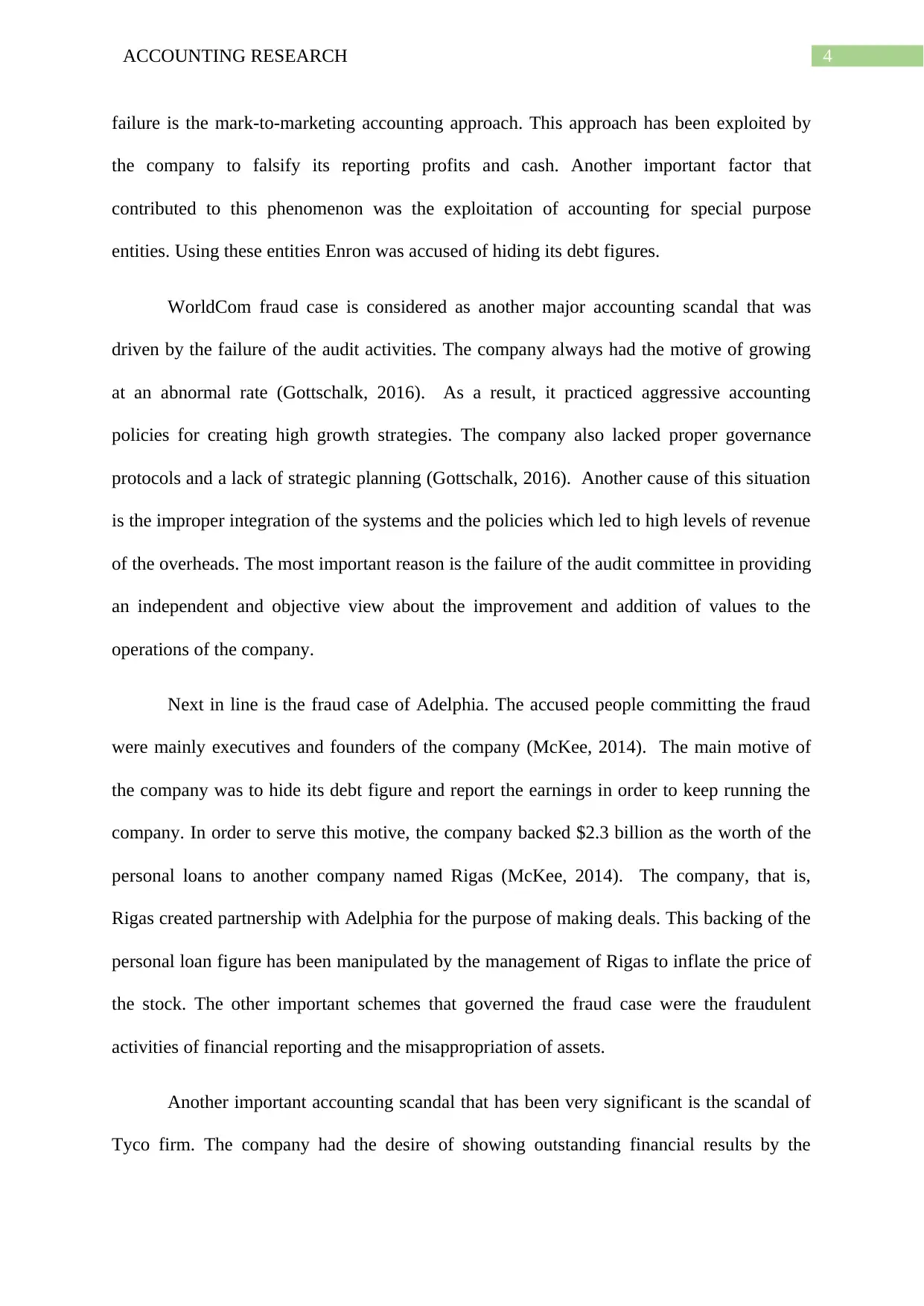
4ACCOUNTING RESEARCH
failure is the mark-to-marketing accounting approach. This approach has been exploited by
the company to falsify its reporting profits and cash. Another important factor that
contributed to this phenomenon was the exploitation of accounting for special purpose
entities. Using these entities Enron was accused of hiding its debt figures.
WorldCom fraud case is considered as another major accounting scandal that was
driven by the failure of the audit activities. The company always had the motive of growing
at an abnormal rate (Gottschalk, 2016). As a result, it practiced aggressive accounting
policies for creating high growth strategies. The company also lacked proper governance
protocols and a lack of strategic planning (Gottschalk, 2016). Another cause of this situation
is the improper integration of the systems and the policies which led to high levels of revenue
of the overheads. The most important reason is the failure of the audit committee in providing
an independent and objective view about the improvement and addition of values to the
operations of the company.
Next in line is the fraud case of Adelphia. The accused people committing the fraud
were mainly executives and founders of the company (McKee, 2014). The main motive of
the company was to hide its debt figure and report the earnings in order to keep running the
company. In order to serve this motive, the company backed $2.3 billion as the worth of the
personal loans to another company named Rigas (McKee, 2014). The company, that is,
Rigas created partnership with Adelphia for the purpose of making deals. This backing of the
personal loan figure has been manipulated by the management of Rigas to inflate the price of
the stock. The other important schemes that governed the fraud case were the fraudulent
activities of financial reporting and the misappropriation of assets.
Another important accounting scandal that has been very significant is the scandal of
Tyco firm. The company had the desire of showing outstanding financial results by the
failure is the mark-to-marketing accounting approach. This approach has been exploited by
the company to falsify its reporting profits and cash. Another important factor that
contributed to this phenomenon was the exploitation of accounting for special purpose
entities. Using these entities Enron was accused of hiding its debt figures.
WorldCom fraud case is considered as another major accounting scandal that was
driven by the failure of the audit activities. The company always had the motive of growing
at an abnormal rate (Gottschalk, 2016). As a result, it practiced aggressive accounting
policies for creating high growth strategies. The company also lacked proper governance
protocols and a lack of strategic planning (Gottschalk, 2016). Another cause of this situation
is the improper integration of the systems and the policies which led to high levels of revenue
of the overheads. The most important reason is the failure of the audit committee in providing
an independent and objective view about the improvement and addition of values to the
operations of the company.
Next in line is the fraud case of Adelphia. The accused people committing the fraud
were mainly executives and founders of the company (McKee, 2014). The main motive of
the company was to hide its debt figure and report the earnings in order to keep running the
company. In order to serve this motive, the company backed $2.3 billion as the worth of the
personal loans to another company named Rigas (McKee, 2014). The company, that is,
Rigas created partnership with Adelphia for the purpose of making deals. This backing of the
personal loan figure has been manipulated by the management of Rigas to inflate the price of
the stock. The other important schemes that governed the fraud case were the fraudulent
activities of financial reporting and the misappropriation of assets.
Another important accounting scandal that has been very significant is the scandal of
Tyco firm. The company had the desire of showing outstanding financial results by the
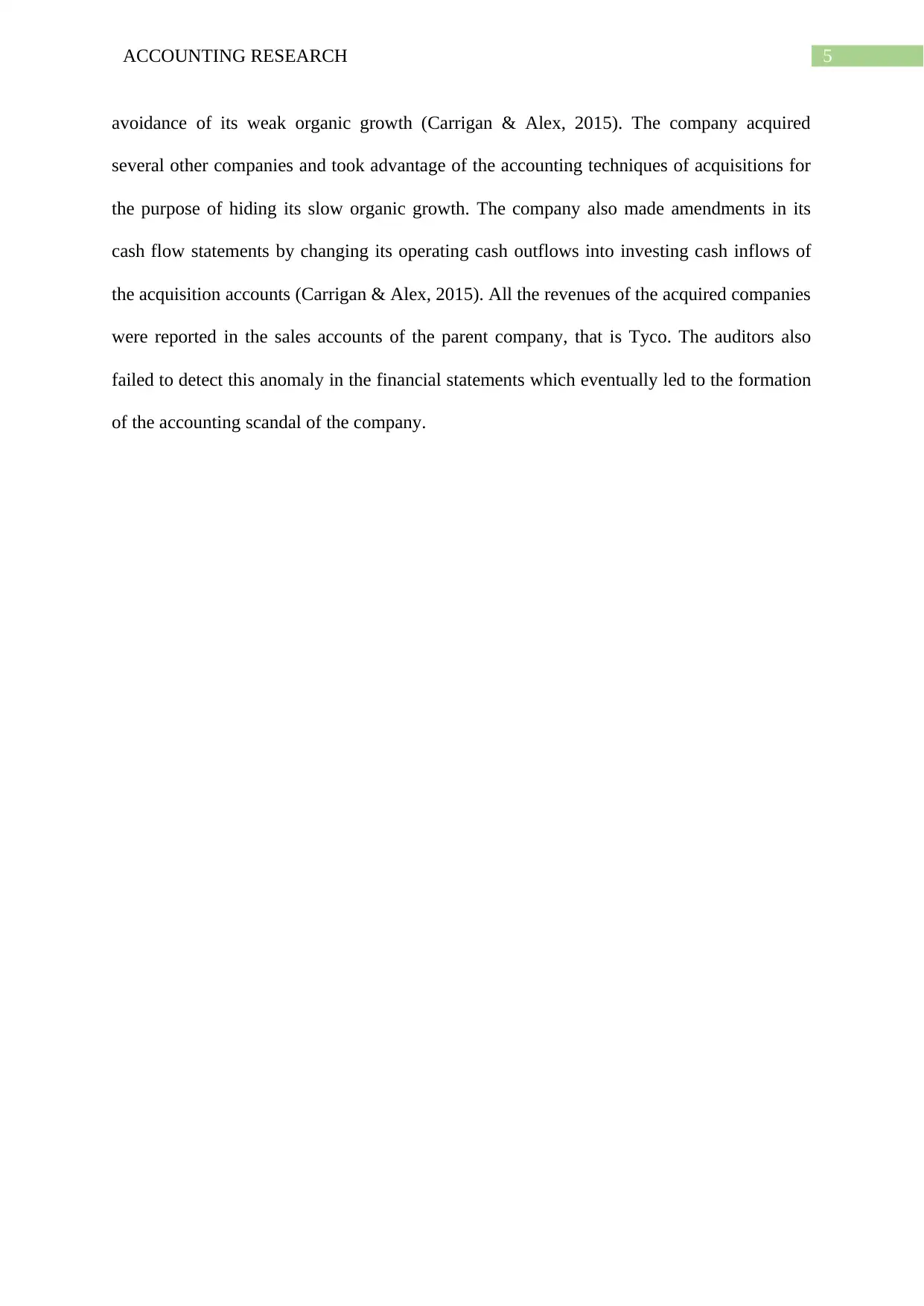
5ACCOUNTING RESEARCH
avoidance of its weak organic growth (Carrigan & Alex, 2015). The company acquired
several other companies and took advantage of the accounting techniques of acquisitions for
the purpose of hiding its slow organic growth. The company also made amendments in its
cash flow statements by changing its operating cash outflows into investing cash inflows of
the acquisition accounts (Carrigan & Alex, 2015). All the revenues of the acquired companies
were reported in the sales accounts of the parent company, that is Tyco. The auditors also
failed to detect this anomaly in the financial statements which eventually led to the formation
of the accounting scandal of the company.
avoidance of its weak organic growth (Carrigan & Alex, 2015). The company acquired
several other companies and took advantage of the accounting techniques of acquisitions for
the purpose of hiding its slow organic growth. The company also made amendments in its
cash flow statements by changing its operating cash outflows into investing cash inflows of
the acquisition accounts (Carrigan & Alex, 2015). All the revenues of the acquired companies
were reported in the sales accounts of the parent company, that is Tyco. The auditors also
failed to detect this anomaly in the financial statements which eventually led to the formation
of the accounting scandal of the company.
⊘ This is a preview!⊘
Do you want full access?
Subscribe today to unlock all pages.

Trusted by 1+ million students worldwide
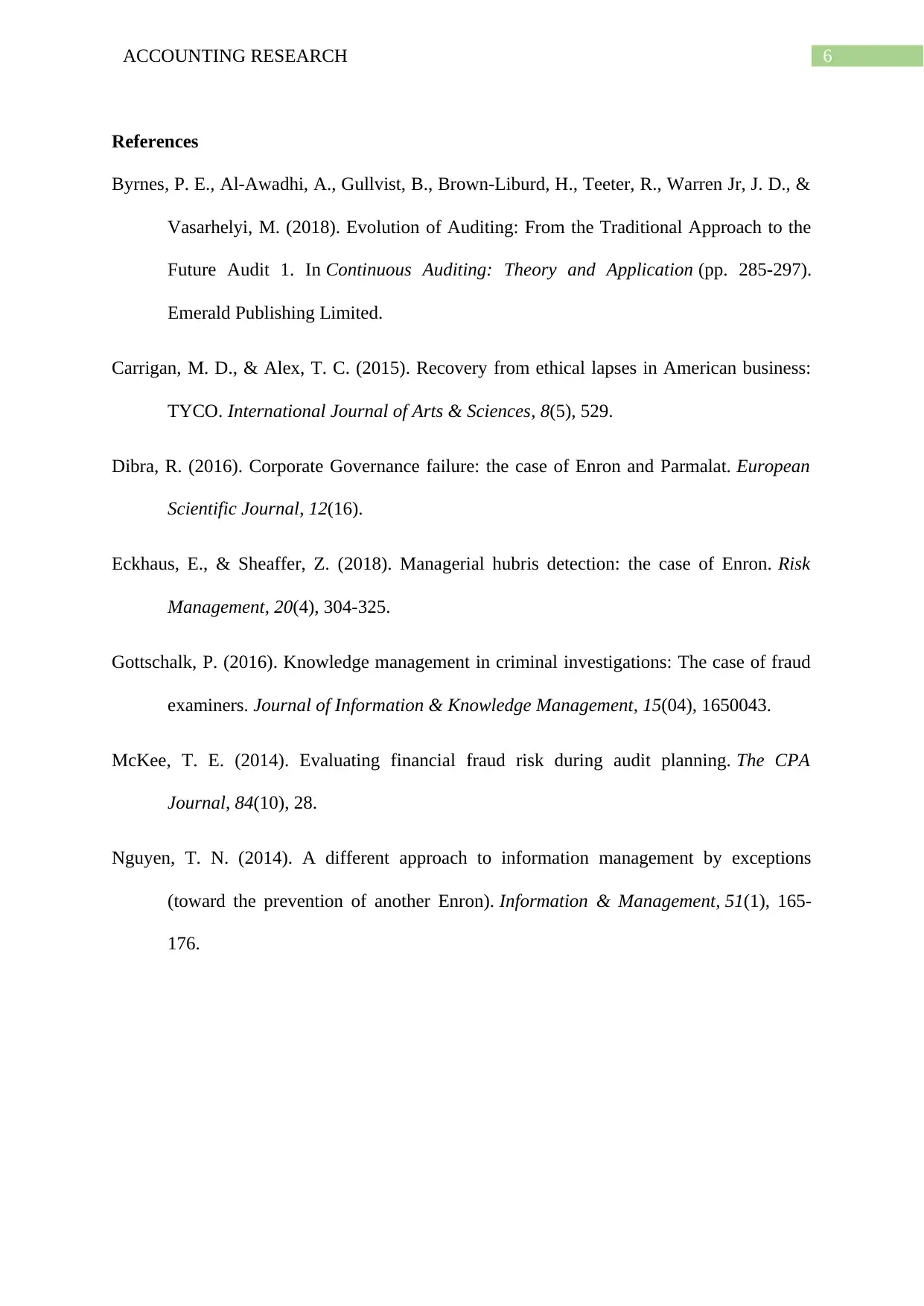
6ACCOUNTING RESEARCH
References
Byrnes, P. E., Al-Awadhi, A., Gullvist, B., Brown-Liburd, H., Teeter, R., Warren Jr, J. D., &
Vasarhelyi, M. (2018). Evolution of Auditing: From the Traditional Approach to the
Future Audit 1. In Continuous Auditing: Theory and Application (pp. 285-297).
Emerald Publishing Limited.
Carrigan, M. D., & Alex, T. C. (2015). Recovery from ethical lapses in American business:
TYCO. International Journal of Arts & Sciences, 8(5), 529.
Dibra, R. (2016). Corporate Governance failure: the case of Enron and Parmalat. European
Scientific Journal, 12(16).
Eckhaus, E., & Sheaffer, Z. (2018). Managerial hubris detection: the case of Enron. Risk
Management, 20(4), 304-325.
Gottschalk, P. (2016). Knowledge management in criminal investigations: The case of fraud
examiners. Journal of Information & Knowledge Management, 15(04), 1650043.
McKee, T. E. (2014). Evaluating financial fraud risk during audit planning. The CPA
Journal, 84(10), 28.
Nguyen, T. N. (2014). A different approach to information management by exceptions
(toward the prevention of another Enron). Information & Management, 51(1), 165-
176.
References
Byrnes, P. E., Al-Awadhi, A., Gullvist, B., Brown-Liburd, H., Teeter, R., Warren Jr, J. D., &
Vasarhelyi, M. (2018). Evolution of Auditing: From the Traditional Approach to the
Future Audit 1. In Continuous Auditing: Theory and Application (pp. 285-297).
Emerald Publishing Limited.
Carrigan, M. D., & Alex, T. C. (2015). Recovery from ethical lapses in American business:
TYCO. International Journal of Arts & Sciences, 8(5), 529.
Dibra, R. (2016). Corporate Governance failure: the case of Enron and Parmalat. European
Scientific Journal, 12(16).
Eckhaus, E., & Sheaffer, Z. (2018). Managerial hubris detection: the case of Enron. Risk
Management, 20(4), 304-325.
Gottschalk, P. (2016). Knowledge management in criminal investigations: The case of fraud
examiners. Journal of Information & Knowledge Management, 15(04), 1650043.
McKee, T. E. (2014). Evaluating financial fraud risk during audit planning. The CPA
Journal, 84(10), 28.
Nguyen, T. N. (2014). A different approach to information management by exceptions
(toward the prevention of another Enron). Information & Management, 51(1), 165-
176.
1 out of 7
Related Documents
Your All-in-One AI-Powered Toolkit for Academic Success.
+13062052269
info@desklib.com
Available 24*7 on WhatsApp / Email
![[object Object]](/_next/static/media/star-bottom.7253800d.svg)
Unlock your academic potential
Copyright © 2020–2025 A2Z Services. All Rights Reserved. Developed and managed by ZUCOL.



